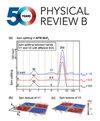反铁磁锯齿链的非共线相位
IF 3.7
2区 物理与天体物理
Q1 Physics and Astronomy
引用次数: 0
摘要
反铁磁锯齿链是一个具有顶点共享三角形的受挫自旋系统的典型例子,产生复杂的量子态。根据相互作用参数的不同,该体系有三个相,其中无间隙的非线性共线相(强耦合的基自旋和松散连接的顶自旋)迄今为止在理论上很少受到关注。在这项工作中,我们利用大规模张量网络计算全面研究了非共线相位的性质,该计算利用了潜在海森堡模型的完全SU(2)对称性。我们用密度-矩阵重整化群(DMRG)研究了有限系统的基态,用变分一致矩阵-积态(VUMPS)方法研究了无限链的基态。有限温度和相关函数通过虚拟或实时演化来解决,我们使用时变分原理(TDVP)实现。我们发现非共线相位的特征是一个低动量峰和一个扩散尾的顶点-顶点相关。在这一阶段的深处,图案逐渐变尖,形成一个90度的螺旋形。顶端自旋柔软,极易受到外界扰动;它们产生大量的无间隙磁态,这些磁态被弱场极化,并在比热中产生一条长长的低温尾巴。动态自旋结构因子表现为两个自旋连续体(基链激发)和k=π/2处的无间隙峰值(顶端自旋激发)的加性贡献。小温度激发了无间隙态,并将k=π/2峰的谱权涂抹成均匀的平带结构。我们的结果是相关的,例如,材料atacamite Cu2Cl(OH)3在高磁场。2025年由美国物理学会出版本文章由计算机程序翻译,如有差异,请以英文原文为准。
Noncollinear phase of the antiferromagnetic sawtooth chain
The antiferromagnetic sawtooth chain is a prototypical example of a frustrated spin system with vertex-sharing triangles, giving rise to complex quantum states. Depending on the interaction parameters, this system has three phases, of which the gapless noncollinear phase (for strongly coupled basal spins and loosely attached apical spins) has received little theoretical attention so far. In this work, we comprehensively investigate the properties of the noncollinear phase using large-scale tensor network computations which exploit the full SU(2) symmetry of the underlying Heisenberg model. We study the ground state both for finite systems using the density-matrix renormalization group (DMRG) as well as for infinite chains via the variational uniform matrix-product state (VUMPS) formalism. Finite temperatures and correlation functions are tackled via imaginary or real time evolutions, which we implement using the time-dependent variational principle (TDVP). We find that the noncollinear phase is characterized by a low-momentum peak and a diffuse tail for the apex-apex correlations. Deep into the phase, the pattern sharpens into a peak indicating a 90∘ spiral. The apical spins are soft and highly susceptible to external perturbations; they give rise to a large number of gapless magnetic states that are polarized by weak fields and cause a long low-temperature tail in the specific heat. The dynamic spin-structure factor exhibits additive contributions from a two-spinon continuum (excitations of the basal chain) and a gapless peak at k = π / 2 k = π / 2 Cu 2 Cl ( OH ) 3 Published by the American Physical Society 2025
求助全文
通过发布文献求助,成功后即可免费获取论文全文。
去求助
来源期刊

Physical Review B
物理-物理:凝聚态物理
CiteScore
6.70
自引率
32.40%
发文量
0
审稿时长
3.0 months
期刊介绍:
Physical Review B (PRB) is the world’s largest dedicated physics journal, publishing approximately 100 new, high-quality papers each week. The most highly cited journal in condensed matter physics, PRB provides outstanding depth and breadth of coverage, combined with unrivaled context and background for ongoing research by scientists worldwide.
PRB covers the full range of condensed matter, materials physics, and related subfields, including:
-Structure and phase transitions
-Ferroelectrics and multiferroics
-Disordered systems and alloys
-Magnetism
-Superconductivity
-Electronic structure, photonics, and metamaterials
-Semiconductors and mesoscopic systems
-Surfaces, nanoscience, and two-dimensional materials
-Topological states of matter
 求助内容:
求助内容: 应助结果提醒方式:
应助结果提醒方式:


